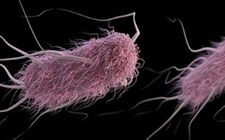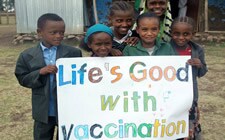Early Release
- Investigation of First Identified mcr-1 Gene in an Isolate from a U.S. Patient — Pennsylvania, 2016
 September 9, 2016
September 9, 2016
In May 2016, mcr-1-positive Escherichia coli was first isolated from a specimen from a U.S. patient when a Pennsylvania woman was evaluated for a urinary tract infection. Although it is not known how the patient became colonized, as more surveillance systems with broader testing are established, it is anticipated thatmcr-1 will be identified with increasing frequency. - Investigation of Escherichia coli Harboring the mcr-1 Resistance Gene – Connecticut, 2016September 9, 2016
In July 2016, the Pathogen Detection System at the National Center for Biotechnology Information identified mcr-1 in the whole genome sequence of an E. coli isolate from a Connecticut patient; this is the fourth isolate from a U.S. patient to contain the mcr-1 gene. No transmission beyond the index patient or persistent environmental contamination were identified, and the patient was transiently colonized.
Current Weekly
- Raccoon Roundworm Infection Associated with Central Nervous System Disease and Ocular Disease — Six States, 2013–2015
 September 9, 2016
September 9, 2016
During May 2013–December 2015, seven cases of baylisascariasis, a disease caused by a ubiquitous roundworm found predominantly in raccoons throughout North America, were identified among patients in the United States through testing at CDC. These included six cases of central nervous system disease and one of ocular disease. - Cessation of Trivalent Oral Poliovirus Vaccine and Introduction of Inactivated Poliovirus Vaccine — Worldwide, 2016
 September 9, 2016
September 9, 2016
To address risks posed by type 2 circulating vaccine-derived polioviruses, the type 2 component of oral poliovirus vaccine (OPV) was scheduled for global withdrawal through a synchronized switch from trivalent oral poliovirus vaccine (tOPV) to bivalent oral poliovirus vaccine (bOPV). All 155 countries and territories using OPV in their immunization programs in 2015 reported that they had completely ceased use of tOPV by mid-May 2016. As of August 31, 173 (89%) of 194 WHO countries had introduced inactivated polio vaccine (IPV) into their immunization programs despite a global shortage of IPV, although 29 of those countries are expected to deplete their supplies of IPV before being resupplied in 2017.
Surveillance Summaries
- National Estimates of Marijuana Use and Related Indicators — National Survey on Drug Use and Health, United States, 2002–2014September 2, 2016
Marijuana is the most commonly used illicit drug in the United States. In 2013, 7.5% (19.8 million) of the U.S. population aged ≥12 years reported using marijuana during the preceding month. Because of certain state-level policies that have legalized marijuana for medical or recreational use, population-based data on marijuana use and other related indicators are needed to help monitor behavioral health changes. This report describes national trends for prevalence of marijuana use; initiation; perception of harm risk, approval, and attitudes; perception of availability and mode of acquisition; dependence and abuse; and perception of legal penalty for marijuana possession.
Recommendations and Reports
- Prevention and Control of Seasonal Influenza with Vaccines: Recommendations of the Advisory Committee on Immunization Practices — United States, 2016–17 Influenza SeasonAugust 26, 2016
This report updates the 2015–16 recommendations of the Advisory Committee on Immunization Practices (ACIP) regarding the use of seasonal influenza. Routine annual influenza vaccination is recommended for all persons aged ≥6 months. For the 2016–17 influenza season, inactivated influenza vaccines (IIVs) will be available in both trivalent (IIV3) and quadrivalent (IIV4) formulations. Recombinant influenza vaccine (RIV) will be available in a trivalent formulation (RIV3). In light of concerns regarding poor effectiveness against influenza A(H1N1)pdm09 in the United States during the 2013–14 and 2015–16 seasons, for the 2016–17 season, ACIP makes the interim recommendation that live attenuated influenza vaccine (LAIV4) should not be used. Vaccine virus strains included in the 2016–17 U.S. trivalent influenza vaccines will be an A/California/7/2009 (H1N1)–like virus, an A/Hong Kong/4801/2014 (H3N2)–like virus, and a B/Brisbane/60/2008–like virus (Victoria lineage). Quadrivalent vaccines will include an additional influenza B virus strain, a B/Phuket/3073/2013–like virus (Yamagata lineage). These recommendations apply to all licensed influenza vaccines used within Food and Drug Administration–licensed indications, including those licensed after the publication date of this report. Updates and other information are available at CDC’s influenza website (http://www.cdc.gov/flu). Vaccination and health care providers should check CDC’s influenza website periodically for additional information.
Supplements
- CDC’s Response to the 2014–2016 Ebola Epidemic — West Africa and United StatesJuly 8, 2016
This historic 2014-2016 Ebola Epidemic in West Africa required a massive international response by multiple partners to assist the affected countries. This supplement present reports that chronicle major aspects of CDC’s response to the Ebola epidemic.
Notifiable Diseases
- Summary of Notifiable Infectious Diseases and ConditionsThe official statistics, in tabular and graphic form, for the reported occurrence of nationally notifiable infectious diseases
- Summary of Notifiable Noninfectious Conditions and Disease OutbreaksThe official statistics, in tabular and graphic form, for the reported occurrence of nationally notifiable noninfectious conditions and disease outbreaks in the United States.


































No hay comentarios:
Publicar un comentario